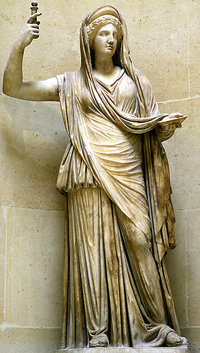|
The Great MotherBy Tala Bar Humans create their deities on the basis of their experience and the way they sense their place in the world. This is what the Hebrew author Agnon writes in his book Sheera: "Although the child is already separated from his mother, it is still strongly attached to its mother and she is attached to it. It is a concrete tie, not just spiritual, and anyone who is versed in the mysteries of creation and knows the meaning of birth, knows that connection between a mother and her child." The adoration of the mother is natural and a matter of fact for anyone who has experienced basic motherly care. This is the first trial and the first experience of any human being in life, and since any person's first experience is that of the relation between mother and child, it is reasonable to assume that the basic, first concept of the deity would be that of the Mother Goddess. Mother Goddesses are known all over the world as most ancient and highly respected deities. Some of the best known are the Northern European Modir, the Greek Hera, the Hindu Bhavani, the Turkish Aka and the African (Zaire) Bahuba. The Mother is a highly appreciated entity even in the earliest monotheistic religion, Judaism, as seen in the classical figure of the Jewish Mother. The mother's initial function is to give birth, which is the most ancient and basic way of creation; and it is significant that only the female of the species is able to do that. In Adele Getty's book Goddess (pp. 66-69) it is said: "The first rite of passage of all human beings begins in the womb and ends between the thighs of the Great Mother." For many peoples, the birth canal itself was sacred, regarded as "the gate of the womb temple keeping the female deity." For humans, however, giving birth is dangerous because of the large size of the human head, and many women may die while doing it, sometimes together with the newborn. This must be the reason why there is a special deity whose function is to monitor birth in order to protect both mother and child. Such goddesses were the Greek Dawn goddess Eos, who was in charge of the birth of the day; the Roman Candelifera, the Aztec Birth goddess Tezcacoac, and the seven Phoenician sister goddesses called The Kothirat. Beyond her part in birth, the mother also has to supply her children with their first food, and for that purpose, it is desirable that her breasts would be flowing with milk. As a result, the suckling mother has become a symbol of divine figure, granting affluence to her children. Ancient clay and stone images of what are usually referred to as Mother Goddess figurines are well known from the Upper Paleolithic, sometimes called "Venus" images; one of these is the image carved in a rock in a cave in Laussel, France, carrying in her hand what is regarded as the Horn of Plenty. Many images include a suckling child at his mother's breast. Well known
is the late period Egyptian statue of the goddess Isis, with her son
Horus on her lap; other images of mother and son from the 6th century
B.C. have been found at Hacilar in Anatolia, as presented in James Mellaart's
book Early Civilizations of the Near East. |
